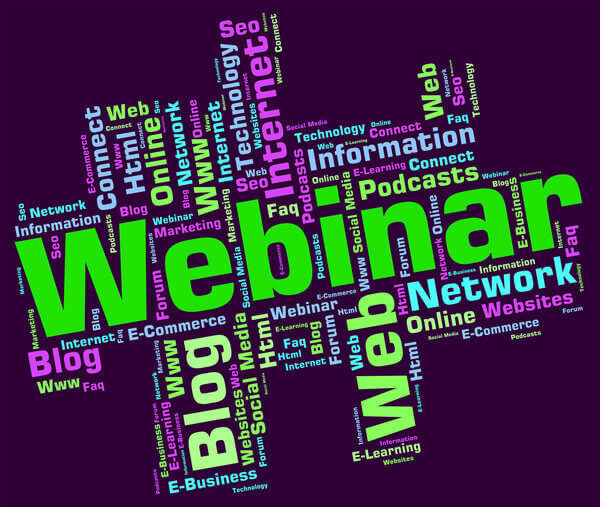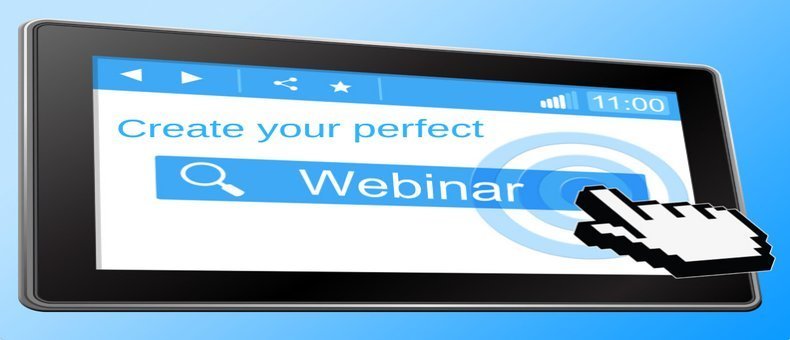Webinars are an effective way to market content , especially static content like research papers or case studies. Think of an engaging perfect webinar like a great radio show that is well produced and includes images. You can break it down into a small theater show with 5 acts.
A perfect webinar that is well produced will take your visitors from "just looking" to "I want it right now". The most recent CMI research shows that 2 out of every 3 B2B marketers have made use of webinars and of that 66 % thought they were valuable.
Like with any kind of event that is well-produced, planning plays a key role. It usually takes 6 to 8 weeks from "let's do this" to "air time" in order to put together a demand-generation webinar. Below we will outline the 5 acts needed to produce a lucrative webinar.
Prologue
Although technology is an important part of the webinar, it has more to do with focusing on what you want your outcomes to be and making sure your business drivers are in alignment. On top of that, you also have to balance the dynamic scheduling, strategic planning, and human elements.
A project management approach with specific deadlines keeps your webinar focused and on schedule. Other important elements include effective best practices, email communications and a way to measure the overall success of a perfect webinar. Every act’s target and process checklist provide you with a solid foundation for a productive strategy.
Act 1 – Laying the foundation for a seamless production
Priority objectives:
- Identify webinar goals and expected results.
- Pinpoint technology resources as well as team expertise required.
- Create a project strategy and launch effectively.
Tasks
- Figure out webinar content: research results, how-to/instructional, or compliance and benchmarks.
- Determine your target market.
- Create a working title.
- Pinpoint target market pain points this webinar tackles.
- Examine if the subject matter is a “nice-to-have” or “must-have”.
- Find sources for subject matter.
- Outline the business goals.
- Specify the call to action (before, throughout, and also after the webinar).
- Breakdown success components and ideal results.
- Figure out the time to take the webinar live.
- Create a project schedule.
- Categorize who is included in the project group.
- Decide if in-house and/or third-party presenters are required.
- Determine which webinar platform you are going to use.We recommend Webinarjam
- Verify if the webinar platform adaptability/integration with online marketing automation software utilities.
- Take a look at sound demands.
- Set up a launch meeting to make sure all involved are on the same page.
- Follow up with players after launch meeting iron out last minute details and get production started.
Bonus:Download our free webinar checklist so you can create your own perfect webinar
Act II – Pulling in your perfect target market


Priority objectives:
- Create the email offer and email marketing campaign timetable.
- Look for email list-sourcing alternatives outside of your in-house list.
- Implement the email marketing campaign.
Tasks
- Decide on an informative value added subject matter that is important to your prospective buyers (like getting rid of an annoyance, detailing the best way to achieve better results, or updating them on marketplace and sector changes).
- Establish a viewer’s profile to match the subject matter and value proposal.
- Information and facts about sectors, employment titles/characteristics, income thresholds as well as your target market geographical locations.
- Measure and source your target market outside of your in-house email list to satisfy your enrollment objectives.
- Pinpoint email list-sourcing alternatives (such as media contributors, trade groups, bought contact subscriber lists).
- What will be the format of the email invitation? Text, HTML or both.
- Make sure that the email invitation deals with the problems of your target audience and deliverables are clear on how they will solve them by attending your webinar.
- Build a landing page specifically for the webinar registration using a webinar hosting service or marketing-automation system).
- Set up the predefined schedule for the email campaign (the number and the start date).
- Generate attention-grabbing headlines for every email
- Setup measurement criteria for the email marketing campaign and daily tracking of registrants.
- Ensure emails conform to CAN-SPAM policies.
- Specify social media marketing platforms.
- Evaluate email and social media marketing promotions prior to launch.
- Implement the email promotion strategy and begin tracking registrants daily.
- Make use of email and enrollment data to figure out if the sales message is attracting your target market and enrollment outcomes.
Act III – Interacting with your target market
Primary objectives:
- Collect and transform enrollment details into a marketing strategy.
- Have a table-read meeting to fine tune the webinar framework and flow.
- Do a preliminary walk-through and dress rehearsal.
Tasks
- Analyze the important email webinar request criteria (delivered, soft bounces, hard bounces, distributed, click rate, open rate, opt-outs/unsubscribes, and spam mail reports).
- Assess the vital webinar results prior to going live. (The click-through ratio CTR is the measure of the number of registered people vs. unregistered people.)
- Collect and evaluate extra enrollment info from the webinar squeeze page (e.g., the things you are able to find out about the company, marketplace, and work function; what they want to learn from the webinar; exactly how did they learn about the webinar?).
- Develop a control panel to observe daily enrollment tracking (e.g., email promotion data by touchpoint, target market demographics, and daily enrollment by touchpoint such as CTR details).
- Keep track of promotion data to make sure they are on target and fine-tune the marketing campaign, if required.
- Think about getting the undecided (people who opened your email message but failed to go through with enrollment) to sign up by delivering follow up emails.
- Set aside 1 hour for the webinar rehearsal.
- Put together and forward the agenda of the rehearsal for important organizers and presenters.
- Go forward with the rehearsal meeting (online or face to face):
- Always make sure that the content of the webinar is aligned with the invite.
- Talk about the framework, timing, and flow.
- Make a production blueprint – pinpoint every section, timeframe, and presenter.
- Create PowerPoint slides and design.
- Be certain that presenters have proper audio tools, give them a USB headphone, if required.
- Set aside one and a half hours for the initial walkthrough.
- Make and forward the agenda for the initial walkthrough.
- Go forward with the initial walkthrough:
- Divulge information collected from daily enrollment.
- Adjust and improve the subject material, where necessary.
- Go through the slideshow.
- Check speakers and sound equipment.
- Start creation of issues for online surveys (icebreaker, conclusion, and next action steps).
- Plan 1 hour 30 minutes for the 2nd walkthrough.
- Make 6 slides as bookends – splash screen, an intro of the presenter, who's on the webinar, housekeeping tasks, strong call to action, Q&A with the pros.
- Generate the concluding poll to determine approval along with additional qualitative observations.
- Create thank-you emails for anyone who participated and no-shows with a hyperlink to see the webinar and also any further action steps to keep the conversation going.
- Tests drive the webinar recording program.
- Proceed with the 2nd walkthrough.
- Perform a timed run through of the slides and polls (icebreaker, closing, and next steps).
- Optimize the moderator’s role.
- Create seed questions for the Q&A.
- Does the story sound natural and authentic?
Bonus:Download our free webinar checklist so you can create your own perfect webinar
Act IV – Making the perfect webinar go live


Main objectives:
- Carry out the final sound test.
- Make webinar live and debrief.
- Implement instant post-webinar action measures.
Tasks
- Arrange the webinar-day timetable.
- Talk to your group 1 hour prior to the start of the webinar.
- Do the last audio test.
- Go over the slide show for the final time.
- Be certain that surveys, polls, and seed queries are uploaded into the webinar system.
- Establish a backup plan – standby sound and platform.
- Record the webinar and give 2 different people the task to produce a backup saving.
- Supply the group with a debriefing phone number to call right after the webinar.
- Switch on the splash display a minimum of 15 minutes prior to the live webinar.
- Turn off any ringers and everything that is able to make noise.
- Turn off non-speakers.
- Deliver a welcome statement to visitors a couple minutes before beginning the broadcast.
- Begin punctually, welcome the viewers, and have a great time.
- Keep track of live monitoring of operation info to determine participation.
- Give a strong call to action and what happens next to your guest a few minutes before ending.
- Finish on time, and show appreciation to the presenters and the visitors.
- Go to a different webinar a 15-minute group debrief.
- Revise the webinar recording to take out housekeeping details and also any sound errors.
- Deliver thank-you email messages within 48 hours after the end of the webinar.
Act V – Converting your visitors
Main objectives:
- Put together the last data and analytics.
- Transform the analytics into action steps for sales staff.
- Evaluate the success of the webinar.
Tasks
- Collect the closing life-cycle details from the marketing automation system and webinar hosting service.
- Evaluate the 6 fundamental webinar criteria: click-through percentage, attendee percentage, webinar surveys, viewer retention, exit evaluations, and live viewings.
- Generate a write-up with a description of the concluding criteria (e.g., email and enrollment criteria, daily enrollment monitoring conclusion, surveys and polls, lead origins profiles, attendee info, and email marketing campaign outcomes).
- Create an executable executive overview.
- Decide which guest is sales-ready, which ones require encouraging, and which ones don't fit.
- Pass the sales-ready potential customers to the sales force.
- Formulate a post-webinar fostering strategy.
- Evaluate if primary planning objectives were achieved.
- Assess the effectiveness the webinar in achieving your business objectives.
- Outline what you learned.
- See whether there is sufficient enthusiasm for another webinar or perhaps a series of webinars.
Bonus:Download our free webinar checklist so you can create your own perfect webinar
Epilogue
Use this template together with your company's best practices and you will get positive results from your webinars and provide value to your target market.
Excited to get your first webinar going? Check out this Webinar software before you get going. We would love to hear your webinar stories. Please share them in the comments section below


